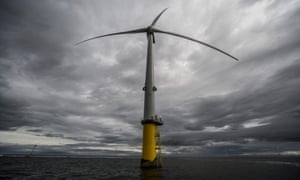
Pic:turbines at the Burbo Bank extension windfarm in Merseyside
Staff reporter(wp):
The planet’s biggest and most powerful wind turbines have begun generating electricity off the Liverpool coast, cementing Britain’s reputation as a world leader in the technology.
Danish company Dong Energy has just finished installing 32 turbines in Liverpool Bay that are taller than the Gherkin skyscraper, with blades longer than nine London buses. Dong Energy, the windfarm’s developer, believes these machines herald the future for offshore wind power: bigger, better and, most importantly, cheaper.
Each of the 195m-tall turbines in the Burbo Bank extension has more than twice the power capacity of those in the neighbouring Burbo Bank windfarm completed a decade ago. “That shows you something about the scale-up of the industry, the scale-up of the technology,” said Benjamin Sykes, the country manager for Dong Energy UK.
The project is the first time the 8MW turbines have been commercially used anywhere in the world, which Sykes hailed as a “very important milestone” for the sector.
Subsidies, friendly regulation and a maritime past have helped the UK install more offshore wind power than any other country in the world. Collectively they now have a capacity of 5.3GW, generating enough electricity to power 4.3m homes. Eight further projects already under construction will add more than half that capacity again.
But ministers have made it clear that the industry must keep cutting costs if the technology, the only large renewable energy source backed by the Conservatives, is to continue earning taxpayer support.
While a recent study showed the cost of offshore wind has fallen a third since 2012, a key litmus test will be the results of a government auction this summer for £290m of renewable energy subsidies.
“I wouldn’t be at all surprised if it comes in below Hinkley,” said Sykes of the prices offshore windfarms might reach, compared to £92.50 per megawatt hour that France’s EDF has been guaranteed for electricity generated by the nuclear power station it is building in Somerset. Previous offshore windfarm subsidy deals have cost well above £100 per megawatt hour.
“This and other projects have been crucial for driving costs down for the whole industry,” said Skyes, pointing to the Burbo Bank extension.
Building fewer but more powerful turbines like these is cheaper because each tower and its blades need a foundation, the “transition piece” that goes atop that, plus the cables to connect it to a nearby substation, and ongoing maintenance.
In Germany, Dong recently made waves when the electricity grid regulator approved its bid to build the world’s first subsidy-free offshore windfarm. While Skyes will not be drawn on when UK windfarms might do the same, he describes this one off Liverpool as “part of the journey to a zero-subsidy windfarm”.
Dong thinks that by the time that German windfarm begins construction, there will be turbines as powerful as 13MW or 15MW. “There’s every reason to think they will arrive,” said Sykes, although he acknowledged eventually they will hit a theoretical limit.
The majority of turbines in UK waters today are between 3.0MW and 3.6MW, with a smattering at 5MW to 7MW, but the Burbo Bank extension is a herald of things to come. Most of the 16 projects which have a planning green light but have not started construction yet will use turbines of at least 8MW.
While the UK benefits from the power from those windfarms, the industry has been criticised in the past for not ensuring enough parts are made in Britain. Dong does not put a figure on what percentage of the Burbo Bank extension is UK built but half the blades are made at MHI Vesta’s Isle of Wight factory; the bits that sit on top of the foundation are built at Teesside.
For people such as Justin Donaghan, the industry also means skilled jobs and a long-term career. The 34-year-old former Royal Navy engineer never saw himself working in green energy before he started working on the original Burbo Bank windfarm seven years ago. He is now a turbine supervisor, looking after the small teams that service the turbines.
“I don’t even think there was a renewable energy sector when I was younger,” he said.